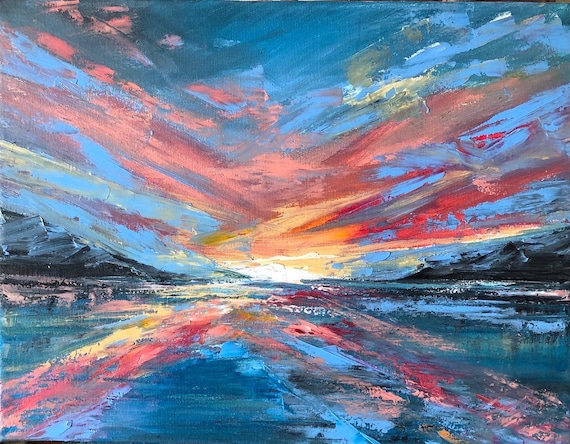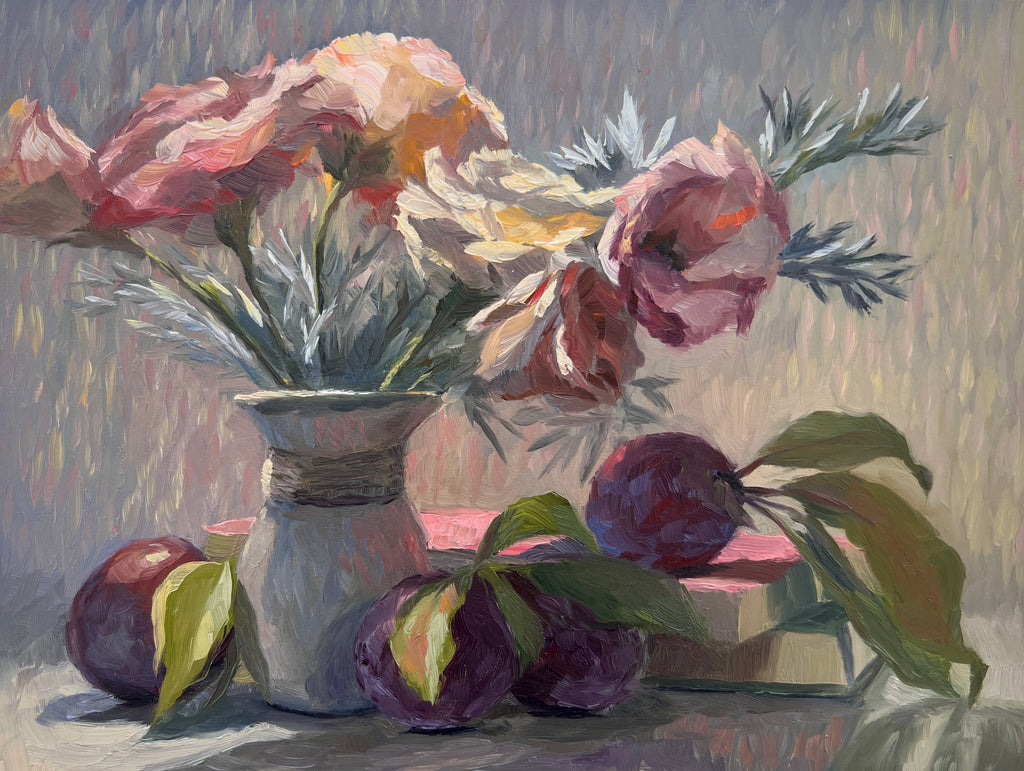Explore Old and Classic Oil Paintings for Sale Online
Explore Old and Classic Oil Paintings for Sale Online
Blog Article
Checking out Everything About Oil Paintings: A Guide to Understanding Their Appeal and Value
Oil paintings have actually captivated target markets for centuries, supplying a glance into the artistic proficiency of different ages. Their rich history is intertwined with cutting-edge techniques and profound psychological expression. Recognizing the products and techniques behind these art work can improve recognition. In addition, the market for oil paintings provides opportunities for capitalists and collection agencies alike. As one discovers this interesting globe, the concern emerges: what makes an oil painting truly valuable?
The Background of Oil Painting: A Trip Through Time
Oil painting has roots that date back to ancient times, it truly thrived throughout the Renaissance, when artists found its flexibility and rich color capacity. Early instances can be traced to the 7th century, with techniques progressing especially across cultures. The tool became noticeable in Northern Europe in the 15th century, particularly via the works of artists like Jan van Eyck, that originated its usage for detailed realistic look and lively shades. This duration noted a departure from tempera paints, enabling for better depth and texture. As oil painting spread, it affected countless musicians, resulting in work of arts by distinguished figures such as Leonardo da Vinci and Rembrandt. The medium's heritage proceeds, forming the art world well into modern-day times.
Understanding Oil Repaints: Products and Techniques
As musicians discover the world of oil paints, they come across a varied range of materials and strategies that define this medium. The primary elements of oil paint consist of pigments, which supply color, and drying out oils, such as linseed, that bind the pigments and assist in application. Various ingredients can change the paint's texture and drying time, improving versatility. Methods like glazing, where transparent layers are developed, and impasto, which includes using thick paint, enable various visual results. In addition, making use of brushes, palette knives, and even fingers can create special structures and finishes. Recognizing these strategies and materials allows artists to completely express their creative thinking and attain the desired impact in their artwork.
The Function of Color in Oil Paintings
Color plays a pivotal function in oil paintings, influencing both aesthetic charm and psychological resonance. Understanding color theory essentials, consisting of the connections in between hues, can improve an artist's capability to communicate mood and ambience. Additionally, grasping shade mixing methods enables greater depth and splendor in a paint's combination.

Shade Concept Essential
Comprehending color theory is necessary for artists functioning with oil paints, as it develops the structure for developing visually appealing and unified structures. Color theory incorporates the study of just how shades communicate, the color wheel, and the connections in between primary, secondary, and tertiary colors. Artists utilize complementary shades to enhance contrasts and produce prime focus, while comparable colors advertise unity and cohesiveness within an item. Additionally, the principles of cool and warm colors influence the perception of depth and area in a painting. Realizing these principles allows musicians to manipulate color properly, directing the audience's eye and communicating their designated message. Proficiency of shade theory ultimately improves an artist's ability to communicate feelings and ideas via their job.
Emotional Influence of Shade
The psychological influence of shade in oil paintings plays an important role in just how viewers link and perceive with art work. Colors stimulate details sensations and state of minds, influencing the customer's mood. For circumstances, cozy shades like oranges and reds can create a sense of heat and energy, while cool tones such as blues and greens usually stimulate peace or introspection. Artists strategically pick color combinations to enhance narrative components, guiding the target market's psychological trip. The saturation and contrast of shades additionally intensify these impacts, attracting interest and developing focus. Eventually, the interaction of shades in oil paintings not only enhances their aesthetic allure yet also acts as a powerful tool for psychological expression, enriching the customer's experience and analysis.
Shade Combining Techniques
While several facets of oil paint add to the total make-up, mastering color mixing techniques is vital for accomplishing preferred effects and deepness. Color mixing can be come close to via numerous techniques, consisting of the subtractive and additive procedures. Additive mixing involves incorporating shades of light, while subtractive mixing relies on pigments, where colors blend to develop brand-new shades. Artists typically make use of a restricted combination to produce harmonious works, understanding the partnerships in between primary, second, and tertiary colors. Strategies such as glazing and scumbling additionally boost depth and luminance. By masterfully blending colors, an artist can stimulate feelings, develop centerpieces, and achieve a sense of realistic look, eventually elevating the painting's aesthetic and psychological effect.
Famous Oil Painters and Their Iconic Works

Famous for their mastery of color and method, oil painters have actually created a few of the most popular artworks in background. Prominent artists like Vincent van Gogh astounded audiences with his emotive brushwork in "Starry Evening," while Claude Monet's "Impression, Sunup" laid the foundation for Impressionism. Leonardo da Vinci's "Mona Lisa" continues to be an enduring symbol of creative wizard, showcasing his ability in capturing human expression. Rembrandt's "The Evening Watch" highlights his ingenious usage of light and darkness. Other significant numbers include Pablo Picasso, that revolutionized modern-day art with his vibrant experimentation in jobs like "Les Demoiselles d'Avignon," and Georgia O'Keeffe, whose dynamic representations of landscapes and blossoms aided specify American innovation. Each artist's one-of-a-kind design added greatly to the oil painting landscape.
Just how to Review the Quality of an Oil Paint
Examining the quality of an oil paint includes a cautious assessment of workmanship strategies, in addition to an analysis of color and make-up. Observing brushwork, layering, and the application of paint can reveal the musician's skill degree. In addition, the interplay of shades and the overall plan of elements contribute considerably to the painting's visual value.
Analyzing Workmanship Strategies
A careful evaluation of craftsmanship strategies is necessary for determining the quality of an oil paint. Critics ought to first take a look at the application of paint; thick, textured brushstrokes may suggest an experienced hand, while overly uniform applications can show an absence of deepness. oil paintings for sale. The layering technique is also essential; the visibility of lusters and differed density can improve luminance and intricacy. In addition, the quality of the products made use of, such as the canvas and pigments, plays a substantial function in sturdiness and total visual. Interest to detail in aspects like sides and changes in between shades mirrors the musician's dedication to their craft. Eventually, these strategies contribute to the paint's psychological impact and market value, functioning as signs of the artist's ability and intent
Evaluating Shade and Structure
While examining the top quality of an oil painting, one must focus on the interaction of shade and make-up, as these elements are essential to the art work's overall impact. Color selections can develop and stimulate emotions mood; therefore, the musician's palette ought to be taken a look at for harmony and contrast. A well-balanced structure routes the audience's eye and creates a sense of unity. Musicians often utilize strategies like the regulation of thirds or leading lines to improve visual passion. Additionally, making use of light and darkness can include deepness, boosting the three-dimensionality of the paint. Eventually, an effective oil paint marries shade and make-up, involving the audience and inviting a much deeper appreciation of the artist's vision and method.
Taking care of and Preserving Oil Paintings
Correct care and conservation of oil paints is crucial for keeping their honesty and longevity. To secure these art work, it is crucial to display them far from direct sunshine, which can trigger fading and staining. Keeping a stable environment with controlled temperature level and humidity additional aids in preventing damage. Cleansing ought to be done gently using a soft, dry towel, preventing any extreme chemicals that might hurt the paint or varnish. Normal assessments for signs of deterioration, such as flaking or breaking, are suggested. When transferring or saving oil paints, appropriate cushioning and framing are needed to prevent physical injury. Ultimately, diligent care adds to the aesthetic allure and worth of oil paintings with time.
The Marketplace for Oil Paints: Gathering and Investing
Recognizing the marketplace dynamics for oil paints is crucial for investors and collection agencies alike. The value of these art work is affected by numerous variables, consisting of the musician's reputation, historic significance, and present fads. Collection agencies often look for pieces that resonate personally while considering possible gratitude in worth. Public auctions and galleries work as primary venues for trading, with rates varying based on need and rarity. Buying oil paintings calls for research right into the market, as well as an understanding of authenticity and provenance. Additionally, emerging musicians might offer opportunities for substantial returns, while established names can command high rates. Generally, a critical approach to gathering can generate both aesthetic satisfaction and financial benefits.

Frequently Asked Concerns
What Are the Environmental Influences of Oil Paint Products?
The ecological effects of oil paint products include the launch of volatile organic substances (VOCs), unsafe waste generation, and source removal for pigments. These factors contribute to pollution and eco-friendly degradation, raising problems amongst ecologically mindful musicians and customers.
Exactly How Do Different Canvases Affect Oil Paint Results?
Various canvases influence oil paint results substantially. Absorbency, surface area, and texture top quality can modify paint application, drying out times, and shade vibrancy. Artists usually choose details canvases to achieve preferred results and boost their imaginative expression.
Can Oil Paintings Be Brought Back if Damaged?
Oil paints can undoubtedly be recovered if harmed. Professional conservators use various techniques to fix tears, clean surfaces, and address staining, guaranteeing that the art work maintains its original appeal and value for future generations.
What Are the Indications of an Initial Oil Paint?
The indications of an original oil painting consist of visible brush strokes, texture variants, and an unequal canvas weave (oil paintings click here for sale). Furthermore, credibility might be verified through provenance, trademarks, and the visibility of a varnish layer one-of-a-kind to oil mediums
How Has Innovation Influenced Modern Oil Paint Techniques?
Technology has actually greatly influenced contemporary oil paint techniques by presenting electronic tools for preparation, boosted products for texture and longevity, and on the internet systems for sharing and marketing art, thus broadening artists' innovative possibilities and target market reach. Oil painting has roots that date back to old times, it truly thrived during the Renaissance, when artists uncovered its adaptability and abundant shade potential. The emotional impact of color in oil paints plays an important duty in exactly how customers link and perceive with art work. While several facets of oil paint add to the overall structure, understanding color blending methods is crucial for accomplishing wanted results and depth. Reviewing the top quality of an oil painting includes a careful analysis of craftsmanship techniques, as well as an analysis of shade and structure. While evaluating the top quality of an oil painting, one need to focus on the interaction of color and structure, as these components are essential to the art work's overall impact.
Report this page